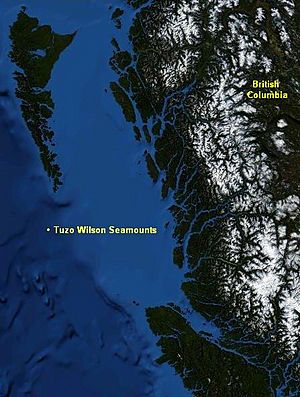Tuzo Wilson Seamounts facts for kids
Quick facts for kids Tuzo Wilson Seamounts |
|
|---|---|

200 km (124 mi) northwest of Vancouver Island
|
|
| Summit depth | ~1,410 m (4,626 ft) |
| Height | 500m-700m |
| Location | |
| Location | 200 km (124 mi) northwest of Vancouver Island |
| Coordinates | 51°24′N 130°54′W / 51.4°N 130.9°W |
| Country | Canada |
| Geology | |
| Type | Submarine volcanoes |
| Volcanic arc/chain | Kodiak-Bowie Seamount chain |
| Age of rock | Holocene |
| Last eruption | Holocene (active) |
The Tuzo Wilson Seamounts are two active underwater volcanoes. They are found off the coast of British Columbia, Canada. These seamounts are about 200 km (124 mi) northwest of Vancouver Island. They are also south of the Haida Gwaii islands.
These two seamounts are part of a larger group. This group is called the Kodiak-Bowie Seamount chain. The Tuzo Wilson Seamounts rise high above the ocean floor. They are 500 m (1,640 ft) to 700 m (2,297 ft) tall. This means they are taller than many big buildings! The area around them often has small earthquakes. These seamounts are named after a famous Canadian geologist named John Tuzo Wilson.
Contents
What are the Tuzo Wilson Seamounts?
The Tuzo Wilson Seamounts are underwater mountains. They were formed by volcanic eruptions. These volcanoes are still active today. This means they could erupt again.
How are they formed?
When volcanoes erupt underwater, they create new land. Over time, this lava builds up. It forms a mountain on the ocean floor. These mountains are called seamounts. The Tuzo Wilson Seamounts are relatively young. This means they formed not too long ago.
What is the lava like?
The lava from these seamounts is a type of rock called basalt. Basalt is usually dark gray or black. It cools very quickly when it touches the cold ocean water. When lava cools fast underwater, it forms special shapes. These shapes look like big pillows. Geologists call them pillow lava.
The lava from these volcanoes has low silica content. This makes it flow more easily. As the lava comes out, it gets a hard crust. Then, more lava pushes out. This causes the crust to crack. New "pillows" of lava ooze out. This process builds up the seamount.
Why are these seamounts special?
Scientists are very interested in the Tuzo Wilson Seamounts. This is because they are active volcanoes. Studying them helps us learn about the Earth's crust. It also helps us understand how volcanoes work underwater.
The Mystery of Their Origin
Scientists have different ideas about how the Tuzo Wilson Seamounts formed. One idea is that they are linked to a hotspot. A hotspot is a very hot area deep inside the Earth. It melts rock and sends lava up to the surface. The lava from these seamounts is fresh and glassy. This fits the idea of a hotspot.
Another idea is that they formed because of rifting. Rifting happens when the Earth's crust pulls apart. The Tuzo Wilson Seamounts are close to an area where the crust is spreading. This area is called the Explorer spreading center.
Scientists are still working to figure out which idea is correct. It's a bit of a mystery! The Kodiak-Bowie Seamount chain also has a mysterious origin. There is a big gap of 360 km (224 mi) between the Tuzo Wilson Seamounts and another active seamount called Bowie Seamount. Both have similar types of lava. If a hotspot caused both, there should be more volcanic activity in between them. This makes the mystery even more interesting for scientists.

